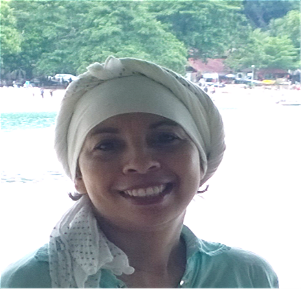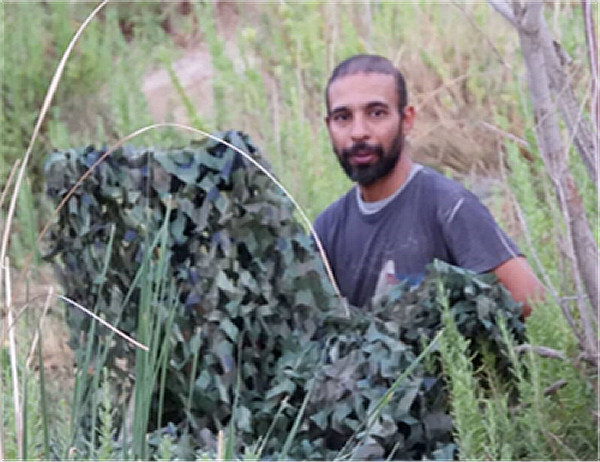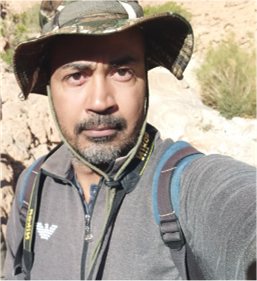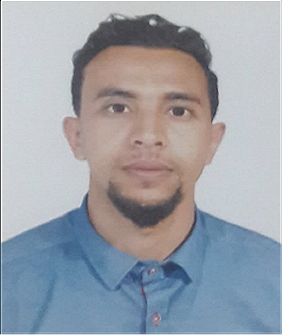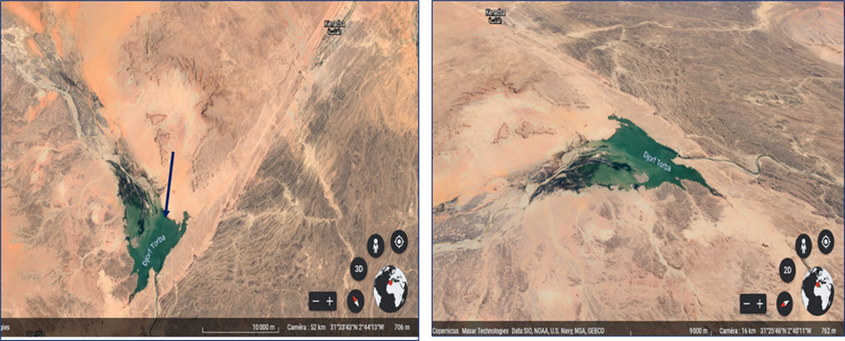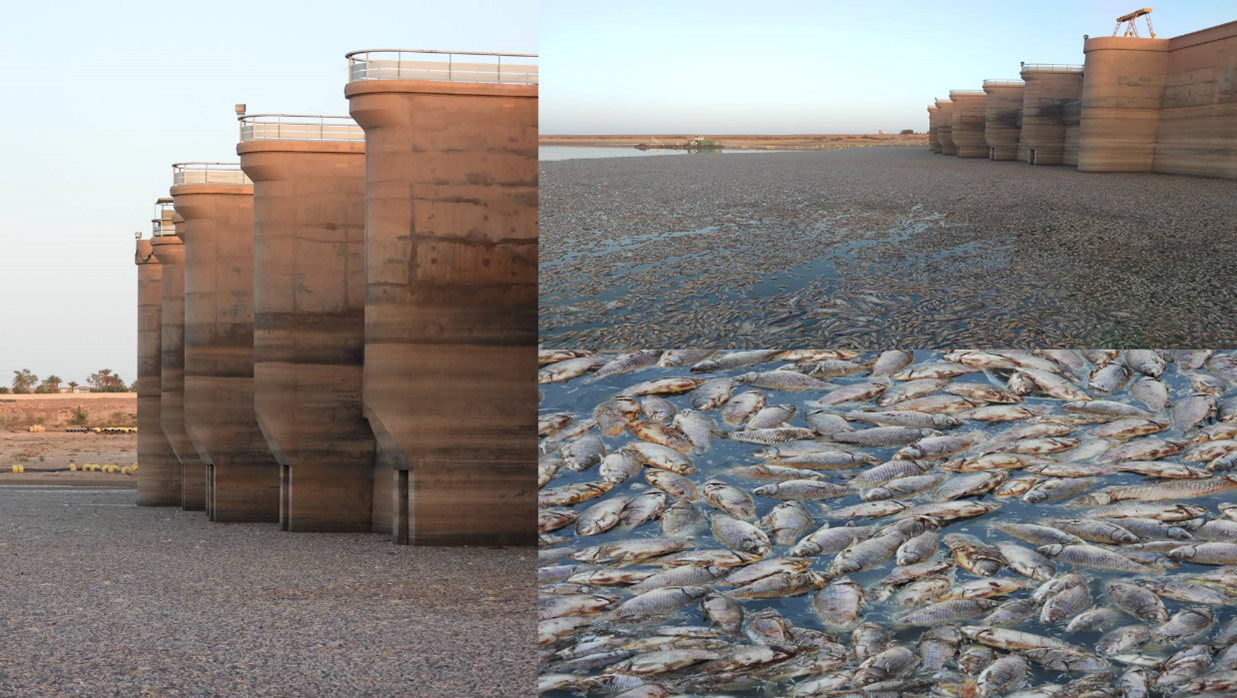IUCN/SSC Otter Specialist Group Bulletin

©IUCN/SCC Otter Specialist Group
Volume 40 Issue 2 (April 2023)
Citation: Seddiki, L.S., Seddiki, F., Kamel, T., Seddiki, A. and Seddiki, S. (2023). The Otter in an Arid Zone - Lake Jorf Torba, Southwest Algeria: Ecology, Diet and Behaviour. IUCN Otter Spec. Group Bull. 40 (2): 72 - 79
The Otter in an Arid Zone - Lake Jorf Torba, Southwest Algeria: Ecology, Diet and Behaviour
Lamia Salima Seddik1, 2*, Fayçal Seddiki2, Torki Kamel2, Amar Seddiki3, and Salim Seddiki2
1Faculty of Science of Life and Nature, Department of Biology, University Tahri Mohamed, Bechar, 08000, Algeria
2Algerian Association of Documenting Wildlife Species, Bechar 08000, Algeria
3University of Tahri Mohamed, Bechar. 08000. Algeria
*Corresponding Author Email: seddiki.lamia@univ-bechar.dz
Received 21st June 2022, accepted 13th November 2022
Abstract: Global warming, anthropological activities, water pollution, integration of non-indigenous species, these factors profoundly influence the biodiversity of Lake Jorf Toba in southwestern Algeria. The environment is becoming more arid, with long heat waves and less precipitation. The conservation of endangered arid zone species is a big challenge, especially if we are talking about a semi-aquatic animal like the Eurasian otter (Lutra lutra). The study aims to evaluate the situation of otters in arid environments such as Lake Jorf Torba. Our data showed the existence of Lutra lutra in the lake, which is an index of food and shelter availability. The major otter forage was Barbus antinorii, Hypophthalmichthys molitrix, Cyprinus carpio, and some arthropods. The otter preferred a rocky shelter to protect itself from the wind, cold and high temperatures. Our observation confirms that the Lutra lutra has always existed in the lake, but during our tracking, we noticed the mortality of two otters. Otters in lake Jorf Torba are a small population, which needs to be protected, and a serious conservation approach should be adopted.
Keywords: Lac Jorf Torba, Otter, Lutra lutra, Conservation, Biodiversity, Arid zone
INTRODUCTION
The arid zones and the desert of Algeria are characterized by a hostile climate, very low precipitation, high temperature, and winds which can be strong; in these conditions, flora and fauna are restricted to number of species.
The Saharan flora is adapted to hostile conditions, and there are a few hundred families of plants in the south-west of Algeria belonging mainly to chamaephytes and therophytes (Guenaia et al., 2019). Oases are the only places where the fauna can develop into a species-rich community, but it is often also a site of human gathering. Anthropogenic action has impacted the number of oases, which limits potential otter habitat. However, the construction of dams such as the Jorf-Torba dam, 40 km southwest of Bechar, provide water and offers a favorable environment for animals to settle, and a resting site for migratory birds.
The Jorf-Torba dam has become a unique artificial lake in the south-west region of Algeria. Its freshwater is supplied by Wadi Guir (from the Moroccan Atlas) and this allows colonization by water animals.
The Eurasian Otter Lutra lutra is categorised as Near Threatened, under the A2c criterion, on the IUCN Red List of Threatened Species (Roos et al, 2021). The first otter record from the arid lands in south-west Algeria was in Igli, south of Jorf-Torba, in 1966 (Dupuy, 1966), before the building of the Jorf-Torba dam. Another record comes from 2009 (Khetar et al., 2009).
This species has been documented in arid and semi-arid zones in Morocco and Tunisia (Macdonald and Mason, 1984), Syria (Jacques, 1998), Jordan (Karami et al., 2006), Iran (Mirzaei et al., 2010), and Iraq (Al-Sheikhly and Nader, 2013). Little information is available on the status of the otter and its environment in Algeria. Libois et al. (2015 b) studied the otters of Kala in the north of the country. The only study in the south is that of Khetar et al. (2010). The objective of the present study is to evaluate the status of the Eurasian Otter in Lake Jorf Torba, in the context of its environment in the lake.
The study was centered on a sector of the Jorf Torba Dam (reservoir) in the northwest of Algeria, 40 km west of Bechar: 31°25’46’’N 2°40’11” W (Fig. 1). Jorf Torba dam is an artificial lake that supports wetland fauna and flora (Fig. 2, 3). The dam receives its water mainly from Oued (=River) Guir; starting from the Moroccan Atlas, the Oued Guir runs for more than 600 km, passing through lake Jorf Toba, then joining the Oued Zouzfana north of Igli (south of province of Bechar around 250km from the Moroccan atlas), where together they form the Oued Saoura (Kabour et al., 2015). Lake Jorf Torba keeps ample water throughout the year. The Saharan zone is characterized by a high temperature which has a direct influence on the reservoir size. The heat period begins practically on the first of June, to extend until September (Coyne et Bellier, 1985). Temperatures are coolest between December and February. Annual rainfall at Jorf Torba was 9-49 mm (Mekkaoui, 2012), but it has decreased in the subsequent decade (Fig. 4).



The most abundant fish in Jorf Torba are Barbus antinorii, Hypophthalmichthys molitrix and Cyprinus carpio. Arthropods include the beetle Blaps gigas. These are eaten by the otter population of Lake Jorf Torba (Khetar et al., 2009, Nait-Larbi and Sellami 2011). The vegetation is mostly riparian, growths of Ephedra alata, Tamarix sp., Launaea sp., Hammada sp., and others (Table 1).
Survey
The observation of otters was focused on otter spraints and/or footprints. The presence of otters was tracked from Afar in Lake Jorf Torba in January 2020 and August 2021. During this period, the temperature was 3 °C higher than expected (December to February), when it should be have been colder and frosty.
RESULTS AND DISCUSSION
Combining records of footprints and observation of the animal, Lake Jorf Torba may hold about six otters (3 young otters were photographed, plus 1 male and 1 female and ± one more otter). Some otter activity is by night. All otters were close to the dam (Fig. 5), where the otter’s shelters were detected in rocky spaces (Fig. 6, 7), a refuge from the wind, cold, and heat. This observation corroborates other studies such as Kruuk (2006), which mentioned otters can use cavities as shelter.
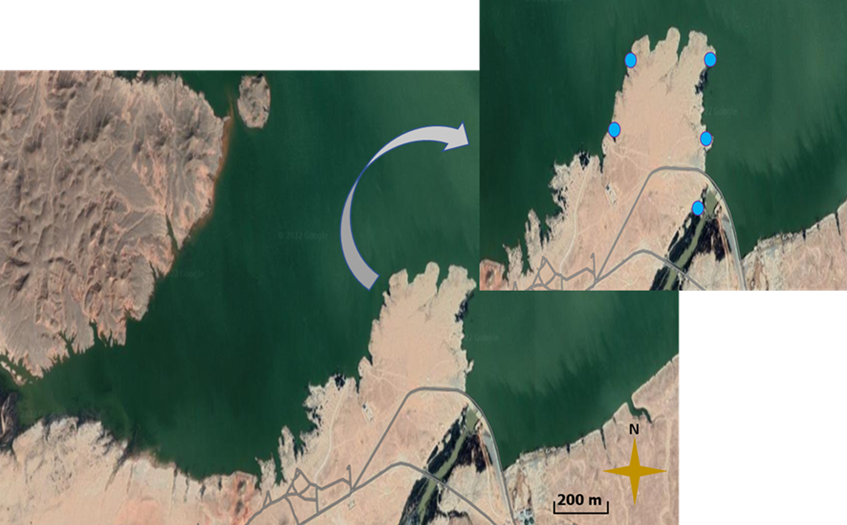
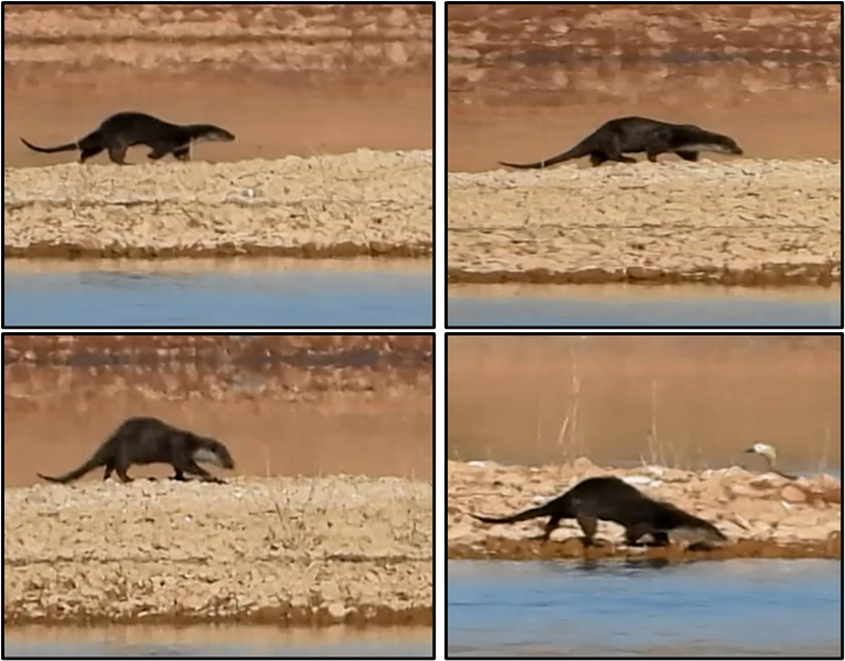
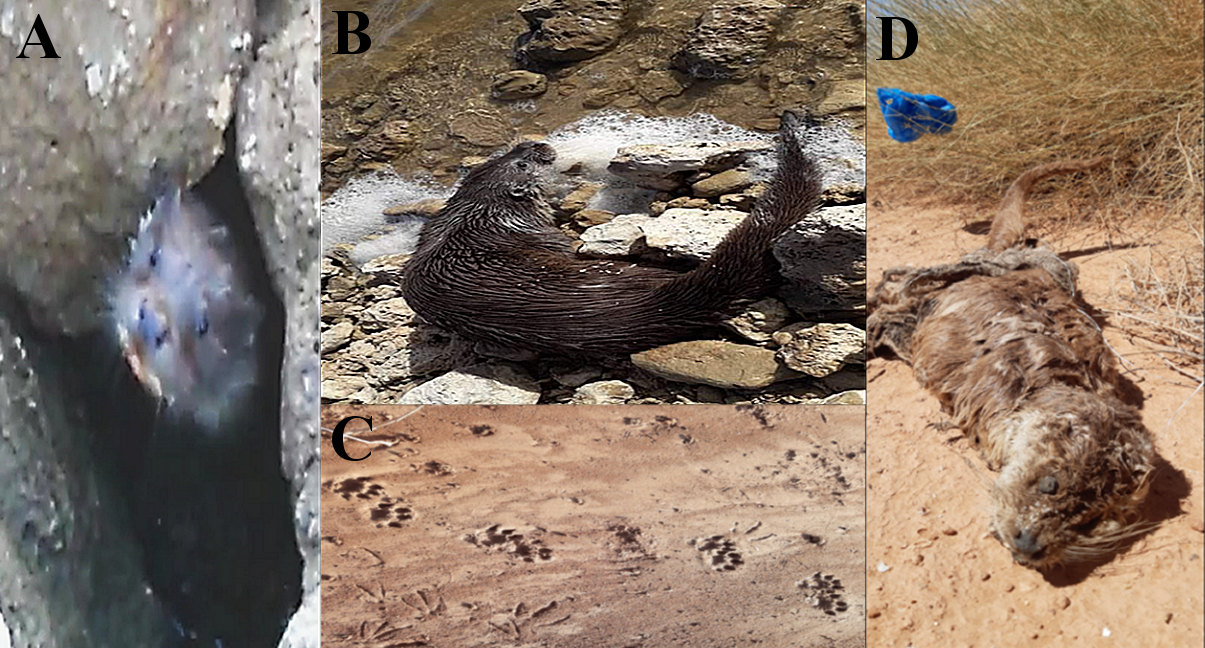
In addition to Lake Jorf Torba, the otter can be found in two other sites: The Abdala dam is 80 km and Igli (Oued zouzfana) is 150 km south of Bechar, where they have been reported by witnesses for years (pers. comm.). However, flooding is getting scarcer than usual. Droughts are becoming more frequent, and the level of the water in Lake Jorf Torba is seriously decreasing. On 15 July 2022, the authorities declared that the dam is completely unusable (Fig. 8). Dams upstream on the Oued Guir and Oued Zouzfana, the source of Lake Jorf Torba, reduce water supply to Jorf Torba, and may threaten the existence of the Eurasian Otter and the lake’s wetland ecosystem. Such dams include Kaddoussa dam, Douisse dam, Oued Zelmou dam and Kheng Alhalouf dam in Morocco.
Human persecution is also an issue for this population of the Eurasian otter. Otters have been taken by traps in the southwest but people do not use the animal's fur.
Consideration has to be given to list Lake Jorf Torba as a wetland site of international importance under the Ramsar convention, to conserve the ecosystem existing in this area, in collaboration with Morrocan ecologists.
Conflict of Interest: The authors declare that they have no known competing financial interests or personal relationships that could have appeared to influence the work reported in this paper.
Acknowledgements: We wish to thank Mr. Walid Zain to support our cause and work on the protection of animals in hamada in Bechar province.
REFERENCES
Al-Sheikhly, O. F., Nader, I. A. (2013). The Status of Iraq smooth-coated Otter Lutrogale perspicillata maxwelli Hayman 1956, and Eurasian Otter Lutra lutra Linnaeus 1758 in Iraq. IUCN Otter Spec. Group Bull., 30(1): 18-30. https://www.iucnosgbull.org/Volume30/AlSheikhly_Nadar_2013.html
Clavero, M., Qninba, A., Riesco, M., Esquivias, J., Calzada, J., & Delibes, M. (2017). Fish in Moroccan deser rivers: the arid extreme of Mediterraenean streams. Fishes in Mediterranean Environments. 003: 21p https://doi.org/10.29094/FiSHMED.2017.003
Coyne et Bellier, (1985). Barrage de Djorf-Torba sur l’Oued Guir. Monographie, Bureau de conseils d’ingénieurie, Paris.
De Silva, P., Yoxon, P. (2021). Asian otter conservation network report 2021. OTTER, Journal of the International Otter Survival Fund, 7: 1-5.
Dupuy, A. (1966). Espèces menacées du territoire algérien. Trav.Inst. Rech. Sahar., 23: 29-56.
Guenaia , A., Hasnaoui , O., Bekkouche , A. (2019). Study of the floristic diversity of Acacia tortilis population- in Bechar region (Southwestern Algeria). South Asian J Exp Biol, 9 (4): 133-141.
Jacques, H. (1998) Eurasian Otter (Lutra lutra) Still Present in Syria. IUCN Otter Spec. Group Bull. 15(2): 112 - 113 https://www.iucnosgbull.org/Volume15/Jacques_1998.html
Kabour, A., Mekkaoui, A., Chebbah, L. (2015). Le barrage de Djorf Torba (Béchar, Sud-Ouest Algérien), sous contraintes du climat, de l’environnement et de gestion. International Journal for Environment& Global ClimateChange, 3 : 23-32.
Karami,M., Mirzaei, R. & Hamzehpour, M. (2006) Status Of Eurasian Otter (Lutra lutra) in Iran IUCN Otter Spec. Group Bull. 23 (1): 28 - 34 https://www.iucnosgbull.org/Volume23/Karami_et_al_2006.html
Khetar, Y., Sellami, M., Biche , M. (2010). Etude préliminaire du régime alimentaire de la loutre d’Europe Lutra lutra (Linné, 1758) dans le barrage de Djorf Torba à Béchar. Ecole Superieur National d’Agronomie. http://dspace.ensa.dz:8080/xmlui/handle/123456789/2092
Kloskowski, J., Rechulicz, J., Jarzynowa, B. (2013). Resource availability and use by Eurasian otters Lutra lutra in a heavily modified river-canal system. Wildl. Biol., 19: 439–452.
Kruuk, H. (2006). Otters Ecology, Behaviour, Conservation. New York: Oxford University Press.
Libois, R., Fareh, M., Brahimi, A., Rosoux, R. (2015 a). Régime alimentaire et stratégie trophique saisonnière de la loutre d’Europe, Lutra lutra, dans le Moyen Atlas (Maroc). Rev. Ecol., 70: 314–327.
Libois, R., Ghalmi, R., Brahimi, A. (2015 b). Insight into the dietary habits of the eurasian otter, Lutra lutra, in the East of Algeria (El-Kala national Park). Ecol. Mediterr, 41: 85-91.
Macdonald, S., Mason, C. (1984). Otters in Morocco. Oryx, 18: 157–159.
Mekkaoui, F. (2012). Le Barrage de Djorf Torba (W. Bechar, Sud-ouest Algérien) : fiche technique et gestion, et estimation des apports liquides et solides. Bechar: University Tahri Mohamed.
Mirzaei, R., Conroy, J., Yoxon, P. (2010). Otters in the Hawr al Azim wetland, Iran. Hystrix, the Italian Journal of Mammalogy, 21(1)| : 83 - 88. https://doi.org/10.4404/hystrix-21.1-4457
Nait-Larbi, H., Sellam, M. (2011). Utilisation des ressources alimentaires par la loutre d’europe : Lutra Lutra (Linné 1758) durant deux saison (été-automne) dans le barrage Jorf-Torba -Bechar. Thèse Doctorale. Ecole Superieur National d’Agronomie.
Nicholson, R. (1991). An investigation into variability within archaeologically recovered assemblages of faunal remains: The influence of pre-depositional taphonomic factors. Unpublished PhD thesis. York University.
Ozenda, P. (1991). Flore et vegetation du sahara. C.N.R.S. 3rd Edition, T.III, Paris, 660 p.
Pl@ntNet (2022). Retrieved from Identify.plantnet: https://identify.plantnet.org
Roos, A., Loy, A., Savage, M. & Kranz, A. (2021). Lutra lutra. The IUCN Red List of Threatened Species 2021: e.T12419A164578163.
https://dx.doi.org/10.2305/IUCN.UK.2021-3.RLTS.T12419A164578163.en
Seddiki, S., El Amine, C. (2021). Modeling of water demand management in an arid area: case of Bechar city. Applied Water Science, 11(5): 87. https://doi.org/10.1007/s13201-021-01403-7
Tela-Botanica. (2022). https://www.tela-botanica.org
Résumé: La Loutre en Zone Aride, Lac Jorf Torba au Sud-Ouest de l'Algéri: Écologie, Alimentation et Comportement
Le réchauffement climatique, l’activités anthropologiques, pollution de l’eau, et l’intégration d'espèces non autochtone, Tout ces facteurs influencent profondément la biodiversité du lac Jorf Toba dans le Sud-Ouest de l'Algérie, l’environnement devient plus aride, de longues vagues de chaleur et moins de précipitations. La conservation des espèces menacées dans les zones arides est un grand défi, surtout s’il s’agit d’un animal semi-aquatique comme la loutre Loutre eurasienne Lutra lutra à Jorf Torba. L’étude vise à évaluer la situation des loutres dans un environnement aride tels que le lac Jorf Torba. Nos données ont montré l’existence de Lutra lutra dans le sud-ouest de l’Algérie dans le lac Jorf Torba, qui est un indice de disponibilité de nourriture et d’abris. Le principal fourrage de la loutre était Barbus antinorii, Hypophthalmichthys molitrix, Cyprinus carpio et certains arthropodes. La loutre préfère un abri rocheux pour se protéger du vent, du froid et des températures élevées. Notre observation confirme que Lutra lutra a toujours existé dans le lac, mais lors de notre repérage, nous avons récupéré deux corps de loutres. La loutre dans le lac de Jorf Torba est une petite population qu’il faut la protégée et adopter une approche de conservation sérieuse.
Revenez au dessus
Resumen: La Nutria en El Lago Jorf Torba, de la Zona Árida del Sudoeste de Argelia: Ecología, Dieta y Comportamiento
El calentamiento global, las actividades antrópicas, la contaminación del agua, la integración de especies no-nativas, todos éstos factores influyen profundamente sobre la biodiversidad del Lago Jorf Torba, en el sudoeste de Argelia; el ambiente se torna más árido, con largas oleadas de calor y menos precipitación. La conservación de especies amenazadas en las zonas áridas es un gran desafío, especialmente si estamos hablando de un animal semi-acuático como la nutria Eurasiática Lutra lutra en Jorf Torba. El estudio está dirigido a evaluar la situación de las nutrias en ambientes áridos como el Lago Jorf Torba. Nuestros datos mostraron la existencia de Lutra lutra en el sudoeste de Argelia, Lago Jorf Torba, lo que indica que hay disponibilidad de alimento y refugio. Los principales alimentos de la nutria fueron Barbus antinorii, Hypophthalmichthys molitrix, Cyprinus carpio, y algunos artrópodos. La nutria prefirió refugios rocosos para protegerse del viento, el frío y las altas temperaturas. Nuestra observación confirma que Lutra lutra siempre ha existido en el lago, pero durante nuestro seguimiento, notamos la mortalidad de dos nutrias. La nutria en el lago Jorf Torba tiene una población pequeña, que necesita ser protegida, y debería adoptarse un enfoque serio de conservación.
Vuelva a la tapa
ملخص
الاحتباس الحراري، الأنشطة الإنسانية، تلوث المياه، تكامل في وجود أنواع حيوانية المهاجرة، تؤثر هذه العوامل بعمق على التنوع البيولوجي لبحيرة الجرف تربة في الجنوب غربي للجزائر، وأصبحت البيئة أكثر جفافاً، وموجات حر طويلة المُدة، وقلة هطول الأمطار. يعتبر الحفاظ على الأنواع المهددة من الانقراض في المنطقة الصحراوية تحديًا كبيرًا، خاصةً إذا كان حيوانًا شبه مائي مثل ثعالب الماء الأورأسي Lutra lutra في بحيرة جرف التربة. تهدف الدراسة إلى تقييم حالة ثعالب الماء في البيئة الجافة مثل بحيرة جرف التربة. أظهرت بياناتنا وجود Lutra lutra في الجنوب الغربي للجزائر في بحيرة الجرفة تربة، وهو مؤشر لتوفُر الغذاء والمأوى. و يتمثَل غذائها ف Barbus antinorii و Hypophthalmichthys molitrix و Cyprinus carpio وبعض المفصليات. يفضل ثعالب الماء المأوى الصخري للحماية من الرياح والبرد ودرجات الحرارة المرتفعة. تُؤكد ملاحظتنا أن Lutra lutra كانت موجودة دائمًا في البحيرة، ولكن أثناء الدراسة الذي أجريناها، لاحظنا وجود جثتين من ثعالب الماء. ثعالب الماء في بحيرة جُرف التُربة هي مجموعة صغيرة تحتاج إلى الحماية وهناك حاجة مُلحة إلى إستراتيجية ناجعة للحفاظ عليها.
العودة إلى البداية
